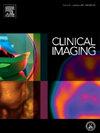肋软骨连接处病变:回顾性回顾126例,图像成像结果,并提出了基于年龄的诊断算法
IF 1.5
4区 医学
Q3 RADIOLOGY, NUCLEAR MEDICINE & MEDICAL IMAGING
引用次数: 0
摘要
背景:影响肋软骨连接处的病变是罕见的,由于广泛的鉴别诊断包括骨、软骨和邻近的软组织结构,因此给诊断带来了挑战。本文总结了来自单中心三级转诊中心的关于该主题的最大已发表数据集之一,并回顾了现有文献,以提供病例示例和年龄分层诊断算法。方法回顾性分析某三级骨科医院肿瘤数据库2007年至2024年间发现的126例成人转诊病例。病例评估基于临床,影像学和组织病理学结果使用局部CRIS和PACS。根据2020年WHO骨肿瘤分类对病变进行分类。结果患者平均年龄49岁,年龄范围7 ~ 85岁。126例患者中,40岁以下42例(33%),40岁以上84例(67%)。40岁以下未见恶性病变。结构异常占主导地位(65.0%),其次是良性病变(16.0%)和恶性病变(19.0%),其中软骨肉瘤是最常见的恶性病变。结论虽然大多数病变为良性或结构性病变,但必须积极考虑恶性病变,尤其是老年患者。结合临床、影像学和组织学数据的评估算法方法可以支持及时和准确的诊断。本文章由计算机程序翻译,如有差异,请以英文原文为准。
Costochondral junction lesions: A retrospective review of 126 cases, pictorial imaging findings, and a proposed age-based diagnostic algorithm
Background
Lesions affecting the costochondral junction are rare and present diagnostic challenges due to a wide differential diagnosis encompassing bone, cartilage, and adjacent soft tissue structures. This article summarises one of the largest published datasets on this topic from a single-centre tertiary referral centre, and reviews the existing literature to provide case examples and age-stratified diagnostic algorithms.
Methods
We conducted a retrospective review of 126 cases identified between 2007 and 2024 from the institutional oncology database of a tertiary orthopaedic hospital, primarily receiving adult referrals. Cases were evaluated based on clinical, imaging, and histopathological findings using the local CRIS and PACS. Lesions were classified according to the 2020 WHO classification of bone tumours.
Results
The mean age was 49 (range: 7 to 85 years old). Of the 126 total cases, 42 cases (33 %) occurred in those under the age of 40, and 84 cases (67 %) were in those 40 and over. No malignant lesions were found in the under 40 years of age. Structural abnormalities predominated (65.0 %), followed by benign lesions (16.0 %) and malignant lesions (19.0 %), with chondrosarcoma being the most common malignancy.
Conclusion
Although most lesions are benign or structural, malignancy must be actively considered, particularly in older patients. An algorithmic approach to evaluation, incorporating clinical, imaging, and histological data, can support timely and accurate diagnosis.
求助全文
通过发布文献求助,成功后即可免费获取论文全文。
去求助
来源期刊

Clinical Imaging
医学-核医学
CiteScore
4.60
自引率
0.00%
发文量
265
审稿时长
35 days
期刊介绍:
The mission of Clinical Imaging is to publish, in a timely manner, the very best radiology research from the United States and around the world with special attention to the impact of medical imaging on patient care. The journal''s publications cover all imaging modalities, radiology issues related to patients, policy and practice improvements, and clinically-oriented imaging physics and informatics. The journal is a valuable resource for practicing radiologists, radiologists-in-training and other clinicians with an interest in imaging. Papers are carefully peer-reviewed and selected by our experienced subject editors who are leading experts spanning the range of imaging sub-specialties, which include:
-Body Imaging-
Breast Imaging-
Cardiothoracic Imaging-
Imaging Physics and Informatics-
Molecular Imaging and Nuclear Medicine-
Musculoskeletal and Emergency Imaging-
Neuroradiology-
Practice, Policy & Education-
Pediatric Imaging-
Vascular and Interventional Radiology
 求助内容:
求助内容: 应助结果提醒方式:
应助结果提醒方式:


